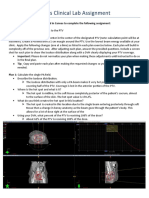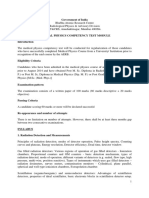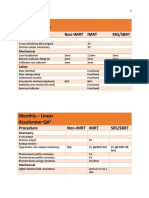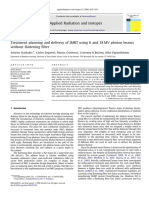Radiation Therapy
Planning Systems
and Dosimetry
Software
Precision, Safety, and Integration in
Radiation Medicine
Learning Objectives
RTPS Algorithms in Dosimetry Clinical Advancements:
Components: Dose Verification: Workflow: Understand the
Understand the Calculation: Understand the Explore how emerging trends
key components Learn about the role of dosimetry RTPS and like AI and real-
of RTPS in different software in dosimetry time adaptive
radiation therapy. algorithms used treatment software therapy.
for dose verification. integrate into
calculation. clinical practice.
Introduction to RTPS and Dosimetry
Software
RTPS:
• Integrates imaging (CT, MRI, PET) to create a 3D model of the patient.
• Used to calculate and optimize the dose distribution to the tumor while sparing healthy tissue.
• Ensures precision and safety during treatment.
Dosimetry Software:
• Verifies the delivered dose by comparing it to the planned dose.
• Helps monitor in vivo dosimetry during treatment to ensure accuracy.
• Prevents errors in dose delivery.
Importance:
• The combination of accurate planning and verification is critical for effective and safe cancer treatment.
Components of Radiation Therapy Planning
Systems (RTPS)
• Key Components:
1. Imaging Integration:
1. CT scans for anatomical reference, MRI for soft tissue contrast, PET for functional imaging.
2. Fusion of images from different modalities for accurate target localization.
2. Contouring Tools:
1. Manual or automatic delineation of tumour volumes (CTV, GTV) and organs-at-risk (OARs).
2. Tools like auto-segmentation for faster and more accurate contouring.
3. Dose Calculation Algorithms:
1. Calculating radiation dose distribution using various algorithms such as Pencil Beam, Monte
Carlo, and Grid-Based Boltzmann Solvers.
4. Plan Optimization:
1. Adjusting the dose distribution to maximize tumour coverage while minimizing dose to OARs.
2. Different approaches like IMRT, VMAT, and SRS/SBRT for specific patient needs.
Workflow in RTPS
Steps in the RTPS Workflow:
1. Imaging Acquisition:
1. High-quality CT/MRI scans used for precise tumor localization. PET can be added for metabolic imaging.
2. Example: A head and neck cancer patient may undergo a PET-CT scan to delineate tumor and metastatic nodes.
2. Contouring:
1. The radiation oncologist or physicist defines the tumor volume (GTV, CTV) and critical structures (OARs) to avoid
overdosage to surrounding tissues.
3. Dose Calculation:
1. Using algorithms (e.g., Monte Carlo) to calculate how radiation will interact with the tumor and healthy tissues.
2. Example: In IMRT, the system calculates beam intensities and angles to deliver the optimal dose distribution.
4. Plan Optimization:
1. Multiple iterations of dose planning are conducted to optimize tumor dose coverage while minimizing exposure
to healthy tissue.
2. Example: VMAT uses rotating gantry angles to deliver precise radiation doses.
5. Quality Assurance:
1. Verification of the plan using phantoms or dosimeters to ensure the plan can be delivered accurately in clinical
practice.
Algorithms in RTPS
Common Algorithms:
1.Pencil Beam Algorithm:
1.Fast, less accurate. Ideal for simple geometries and low-energy beams.
2.Used for treatments like 3D-CRT (3D Conformal Radiation Therapy).
2.Monte Carlo Simulation:
1.High accuracy but computationally intensive.
2.Ideal for complex geometries, heterogeneous tissues (e.g., lung tissue
with air pockets).
3.Standard for brachytherapy and small-field dose calculations.
3.Grid-Based Boltzmann Solvers:
1.Intermediate in terms of accuracy and computational demand.
2.Widely used for IMRT and VMAT due to their speed and sufficient
precision.
Table comparing these algorithms by accuracy,
computational time, and clinical applications.
Algorithm Accuracy Computational Time Clinical Applications
Simple treatment
Pencil Beam Moderate Fast plans, routine clinical
use
Complex geometries,
irregular dose
Monte Carlo High Slow
distributions, quality
assurance
Complex geometries,
Analytical
irregular dose
Anisotropic High Moderate
distributions, routine
Algorithm (AAA)
clinical use
Dosimetry Software: Purpose and Tools
Purpose of Dosimetry Software:
• Verify Dose Delivery: Confirms that the dose
delivered to the patient is as planned.
• In Vivo Dosimetry: Monitors real-time dose delivery
during the radiation treatment.
• Post-Treatment Analysis: Reviews treatment
outcomes to ensure efficacy and safety.
Dosimetry Software: Purpose and Tools
Dosimetry Tools:
• Diode Detectors: Measure dose directly during
treatment.
• Ionization Chambers: Used for precise dose
measurement in phantom studies.
• Thermoluminescent Dosimeters (TLDs): Record
absorbed radiation dose for patient verification.
• Electronic Portal Imaging Devices (EPIDs):
Used to verify beam alignment and dose
distribution on the patient.
Dosimetry Software: Purpose and Tools
Workflow of Dosimetry Software
Dosimetry Workflow:
1.Pre-Treatment Verification:
1. Measured dose vs. planned dose comparison (using phantom studies).
2. Example: A phantom is irradiated, and dosimeters are placed to check for
alignment with the treatment plan.
2.In Vivo Dosimetry:
1. Monitoring dose during actual treatment delivery.
2. Example: Using an EPID to verify if the radiation beam is aligned with the
tumor target during treatment.
3.Post-Treatment Analysis:
1. Reviewing any discrepancies between planned and delivered doses.
2. Example: Analyzing a case where the delivered dose exceeded the
tolerance level of a critical organ.
Integration of RTPS and Dosimetry Software
• Key Integration Aspects:
• RTPS generates the treatment plan, and dosimetry software ensures
its correct delivery.
• Data Flow: DICOM RT files transfer the treatment plan data to
dosimetry software.
• Real-Time Feedback: Continuous feedback from dosimetry
software during radiation therapy to adjust the delivery if necessary.
• Importance of Integration:
• Reduces the chances of errors in treatment delivery, ensuring that
the tumor receives the correct dose while protecting healthy tissue.
Quality Assurance in RTPS and Dosimetry
Importance of QA:
• Ensures the treatment plan is safe and accurately
delivered.
• Detects errors early, preventing potentially harmful
patient outcomes.
QA Techniques:
• Phantom Studies: Using an anthropomorphic
phantom to simulate patient treatment.
• End-to-End Testing: Ensures that all systems
(imaging, planning, delivery) work together seamlessly.
• Software Validation: Periodic checks to ensure
software algorithms are working as intended.
Challenges and Limitations
RTPS Challenges:
• Computational Time: Some algorithms (e.g., Monte Carlo) require
extensive time for calculations, limiting their use for real-time
applications.
• Imaging Artifacts: Low-quality or noisy images can affect
accurate tumor contouring.
Dosimetry Challenges:
• Calibration: Ensuring that dosimetry devices are correctly
calibrated to provide accurate measurements.
• Discrepancies in Delivered Dose: Variations between planned
and actual dose may arise due to patient movement or machine
malfunctions.
Advancements and Emerging Trends
AI in RTPS:
• Automated Contouring: AI algorithms can automatically segment structures, reducing time
and interobserver variability.
• Adaptive Therapy: Real-time adjustments to treatment plans based on anatomical changes
(e.g., tumor shrinkage).
Real-Time Adaptive Therapy:
• Adjusting the radiation delivery based on real-time imaging.
• Example: A lung cancer treatment plan can be adjusted based on daily changes in tumor
position due to respiratory motion.
Cloud-Based Systems:
• Collaboration between different clinics and hospitals via cloud-based platforms for storing and
accessing treatment plans.
• Benefits: Improved accessibility, data sharing, and remote consultations.
Summary and Q&A
Key Points:
• RTPS and dosimetry software are integral to
precise and safe radiation therapy.
• Accurate dose calculation and verification
prevent errors in patient treatment.
• Ongoing advancements, such as AI and real-
time adaptive therapy, are reshaping radiation
oncology.
Study Guide for
Final Exam
Overview of Key Topics
• The exam will cover a range of topics with more emphasis on the
following areas:
• PACS (Picture Archiving and Communication Systems)
• DICOM and HL7 Standards
• Cybersecurity and Data Protection in Medical Radiation
• Ethical Considerations in AI and Machine Learning Applications
in Radiation Medicine
Exam Structure
• Section A: 10 multiple choice questions (1 mark each)
• Section B: 8 short answer questions (5 marks each) — answer 6
• Section C: 3 case study extended response questions (10 marks each)
— answer 1
Important Concepts to Study
• Topic 1: PACS and Data Management
• Key Functions of PACS: Understand the core functions such as image
storage, retrieval, sharing, and integration into clinical workflows. Be
able to explain how PACS improves efficiency in radiology departments.
• Role of DICOM: The DICOM standard is essential for interoperability
across various medical imaging devices and systems. Know the
structure of DICOM files and its importance in clinical environments.
• HL7 Standard: Understand how HL7 facilitates the exchange of health
information, especially for patient demographics and clinical data.
Important Concepts to Study
• Topic 2: Cybersecurity in Radiation Medicine
• Common Cybersecurity Threats: Study threats such
as ransomware, phishing, and data breaches, focusing
on their impact on healthcare IT systems.
• Protective Measures: Understand encryption, access
controls, multi-factor authentication, and other methods
for securing patient data.
• Regulatory Compliance: Familiarize yourself with
regulations like HIPAA that govern data protection in
healthcare.
Important Concepts to Study
• Topic 3: Ethical and Legal Considerations
• AI and Medical Imaging: Explore the ethical concerns
surrounding AI tools with biases in demographic groups
and their implications for patient care.
• Data Privacy and Protection: Understand the legal
frameworks for patient data protection and methods of
de-identifying data to protect privacy.
• Informed Consent: Learn about the importance of
obtaining patient consent before using AI or new
medical technologies.





























































































